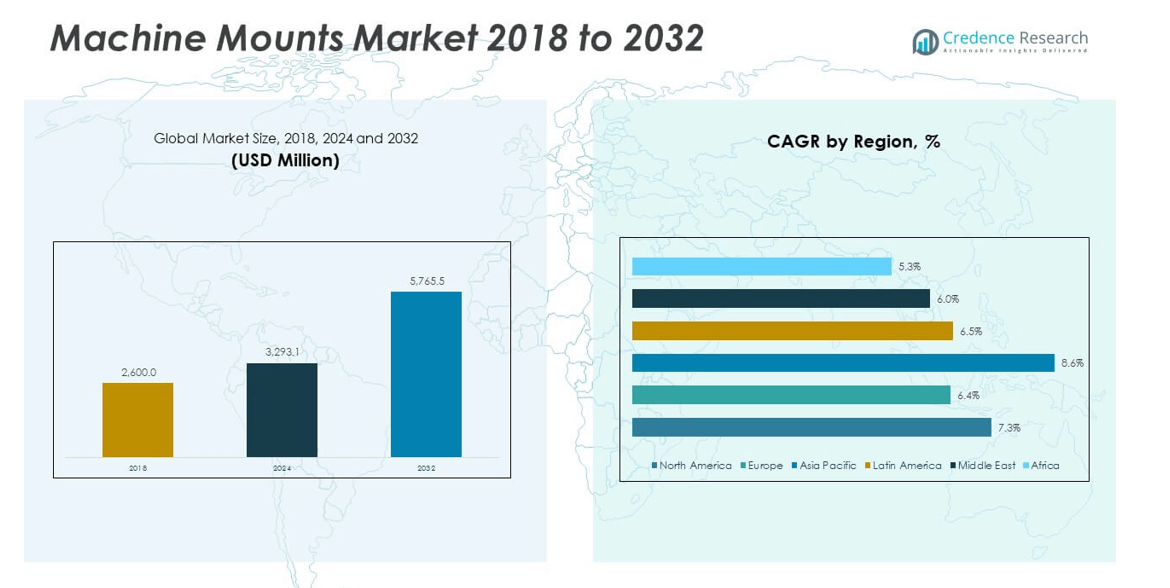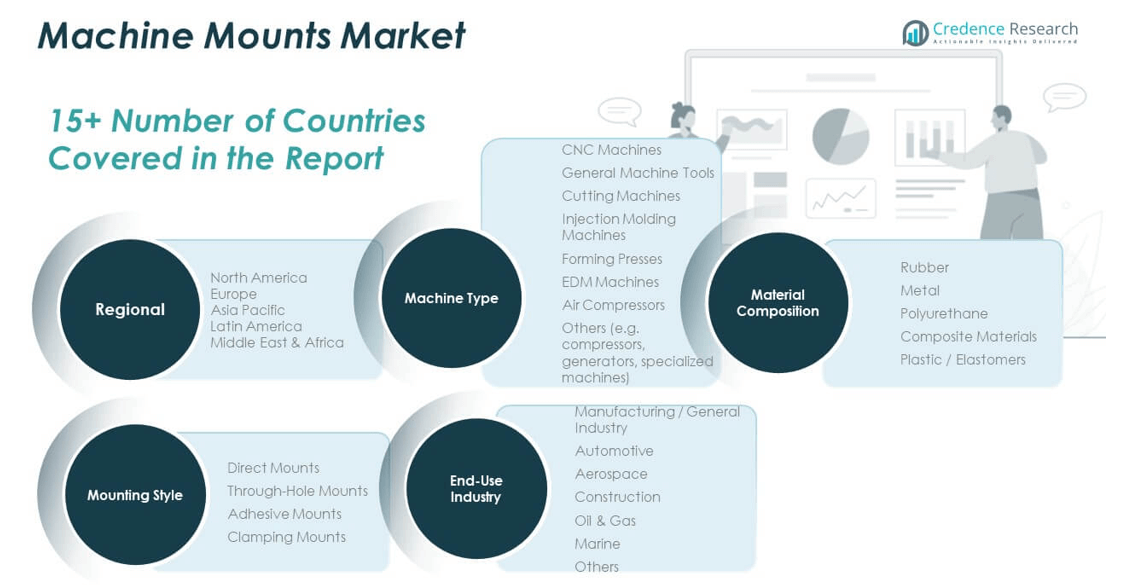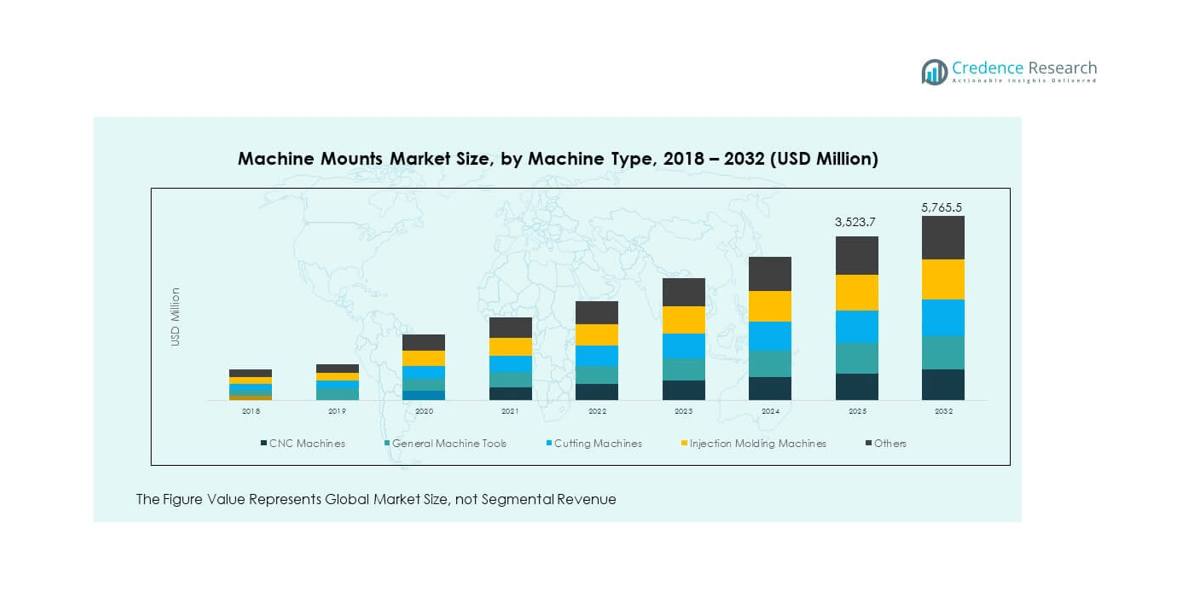CHAPTER NO. 1 : GENESIS OF THE MARKET
1.1 Market Prelude – Introduction & Scope
1.2 The Big Picture – Objectives & Vision
1.3 Strategic Edge – Unique Value Proposition
1.4 Stakeholder Compass – Key Beneficiaries
CHAPTER NO. 2 : EXECUTIVE LENS
2.1 Pulse of the Industry – Market Snapshot
2.2 Growth Arc – Revenue Projections (USD Million)
2.3. Premium Insights – Based on Primary Interviews
CHAPTER NO. 3 : MACHINE MOUNTS MARKET FORCES & INDUSTRY PULSE
3.1 Foundations of Change – Market Overview
3.2 Catalysts of Expansion – Key Market Drivers
3.2.1 Momentum Boosters – Growth Triggers
3.2.2 Innovation Fuel – Disruptive Technologies
3.3 Headwinds & Crosswinds – Market Restraints
3.3.1 Regulatory Tides – Compliance Challenges
3.3.2 Economic Frictions – Inflationary Pressures
3.4 Untapped Horizons – Growth Potential & Opportunities
3.5 Strategic Navigation – Industry Frameworks
3.5.1 Market Equilibrium – Porter’s Five Forces
3.5.2 Ecosystem Dynamics – Value Chain Analysis
3.5.3 Macro Forces – PESTEL Breakdown
3.6 Price Trend Analysis
3.6.1 Regional Price Trend
3.6.2 Price Trend by product
CHAPTER NO. 4 : KEY INVESTMENT EPICENTER
4.1 Regional Goldmines – High-Growth Geographies
4.2 Product Frontiers – Lucrative Product Categories
4.3 Material Composition Sweet Spots – Emerging Demand Segments
CHAPTER NO. 5: REVENUE TRAJECTORY & WEALTH MAPPING
5.1 Momentum Metrics – Forecast & Growth Curves
5.2 Regional Revenue Footprint – Market Share Insights
5.3 Segmental Wealth Flow – Machine Type & Material Composition Revenue
CHAPTER NO. 6 : TRADE & COMMERCE ANALYSIS
6.1. Import Analysis by Region
6.1.1. Global Machine Mounts Market Import Revenue By Region
6.2. Export Analysis by Region
6.2.1. Global Machine Mounts Market Export Revenue By Region
CHAPTER NO. 7 : COMPETITION ANALYSIS
7.1. Company Market Share Analysis
7.1.1. Global Machine Mounts Market: Company Market Share
7.2. Global Machine Mounts Market Company Revenue Market Share
7.3. Strategic Developments
7.3.1. Acquisitions & Mergers
7.3.2. New Product Launch
7.3.3. Regional Expansion
7.4. Competitive Dashboard
7.5. Company Assessment Metrics, 2024
CHAPTER NO. 8 : MACHINE MOUNTS MARKET – BY MACHINE TYPE SEGMENT ANALYSIS
8.1. Machine Mounts Market Overview by Machine Type Segment
8.1.1. Machine Mounts Market Revenue Share By Machine Type
8.2. CNC Machines
8.3. General Machine Tools
8.4. Cutting Machines
8.5. Injection Molding Machines
8.6. Forming Presses
8.7. EDM Machines
8.8. Air Compressors
8.9. Others (e.g. compressors, generators, specialized machines)
CHAPTER NO. 9 : MACHINE MOUNTS MARKET – BY MATERIAL COMPOSITION SEGMENT ANALYSIS
9.1. Machine Mounts Market Overview by Material Composition Segment
9.1.1. Machine Mounts Market Revenue Share By Material Composition
9.2. Rubber
9.3. Metal
9.4. Polyurethane
9.5. Composite Materials
9.6. Plastic / Elastomers
CHAPTER NO. 10 : MACHINE MOUNTS MARKET – BY MOUNTING STYLE SEGMENT ANALYSIS
10.1. Machine Mounts Market Overview by Mounting Style Segment
10.1.1. Machine Mounts Market Revenue Share By Mounting Style
10.2. Direct Mounts
10.3. Through‑Hole Mounts
10.4. Adhesive Mounts
10.5. Clamping Mounts
CHAPTER NO. 11 : MACHINE MOUNTS MARKET – BY END‑USE INDUSTRY SEGMENT ANALYSIS
11.1. Machine Mounts Market Overview by End‑Use Industry Segment
11.1.1. Machine Mounts Market Revenue Share By End‑Use Industry
11.2. Manufacturing / General Industry
11.3. Automotive
11.4. Aerospace
11.5. Construction
11.6. Oil & Gas
11.7. Marine
11.8. Others
CHAPTER NO. 12 : MACHINE MOUNTS MARKET – REGIONAL ANALYSIS
12.1. Machine Mounts Market Overview by Region Segment
12.1.1. Global Machine Mounts Market Revenue Share By Region
12.1.2. Regions
12.1.3. Global Machine Mounts Market Revenue By Region
12.1.4. Machine Type
12.1.5. Global Machine Mounts Market Revenue By Machine Type
12.1.6. Material Composition
12.1.7. Global Machine Mounts Market Revenue By Material Composition
12.1.8. Mounting Style
12.1.9. Global Machine Mounts Market Revenue By Mounting Style
12.1.10. End‑Use Industry
12.1.11. Global Machine Mounts Market Revenue By End‑Use Industry
CHAPTER NO. 13 : NORTH AMERICA MACHINE MOUNTS MARKET – COUNTRY ANALYSIS
13.1. North America Machine Mounts Market Overview by Country Segment
13.1.1. North America Machine Mounts Market Revenue Share By Region
13.2. North America
13.2.1. North America Machine Mounts Market Revenue By Country
13.2.2. Machine Type
13.2.3. North America Machine Mounts Market Revenue By Machine Type
13.2.4. Material Composition
13.2.5. North America Machine Mounts Market Revenue By Material Composition
13.2.6. Mounting Style
13.2.7. North America Machine Mounts Market Revenue By Mounting Style
13.2.8. End‑Use Industry
13.2.9. North America Machine Mounts Market Revenue By End‑Use Industry
13.3. U.S.
13.4. Canada
13.5. Mexico
CHAPTER NO. 14 : EUROPE MACHINE MOUNTS MARKET – COUNTRY ANALYSIS
14.1. Europe Machine Mounts Market Overview by Country Segment
14.1.1. Europe Machine Mounts Market Revenue Share By Region
14.2. Europe
14.2.1. Europe Machine Mounts Market Revenue By Country
14.2.2. Machine Type
14.2.3. Europe Machine Mounts Market Revenue By Machine Type
14.2.4. Material Composition
14.2.5. Europe Machine Mounts Market Revenue By Material Composition
14.2.6. Mounting Style
14.2.7. Europe Machine Mounts Market Revenue By Mounting Style
14.2.8. End‑Use Industry
14.2.9. Europe Machine Mounts Market Revenue By End‑Use Industry
14.3. UK
14.4. France
14.5. Germany
14.6. Italy
14.7. Spain
14.8. Russia
14.9. Rest of Europe
CHAPTER NO. 15 : ASIA PACIFIC MACHINE MOUNTS MARKET – COUNTRY ANALYSIS
15.1. Asia Pacific Machine Mounts Market Overview by Country Segment
15.1.1. Asia Pacific Machine Mounts Market Revenue Share By Region
15.2. Asia Pacific
15.2.1. Asia Pacific Machine Mounts Market Revenue By Country
15.2.2. Machine Type
15.2.3. Asia Pacific Machine Mounts Market Revenue By Machine Type
15.2.4. Material Composition
15.2.5. Asia Pacific Machine Mounts Market Revenue By Material Composition
15.2.6. Mounting Style
15.2.7. Asia Pacific Machine Mounts Market Revenue By Mounting Style
15.2.8. End‑Use Industry
15.2.9. Asia Pacific Machine Mounts Market Revenue By End‑Use Industry
15.3. China
15.4. Japan
15.5. South Korea
15.6. India
15.7. Australia
15.8. Southeast Asia
15.9. Rest of Asia Pacific
CHAPTER NO. 16 : LATIN AMERICA MACHINE MOUNTS MARKET – COUNTRY ANALYSIS
16.1. Latin America Machine Mounts Market Overview by Country Segment
16.1.1. Latin America Machine Mounts Market Revenue Share By Region
16.2. Latin America
16.2.1. Latin America Machine Mounts Market Revenue By Country
16.2.2. Machine Type
16.2.3. Latin America Machine Mounts Market Revenue By Machine Type
16.2.4. Material Composition
16.2.5. Latin America Machine Mounts Market Revenue By Material Composition
16.2.6. Mounting Style
16.2.7. Latin America Machine Mounts Market Revenue By Mounting Style
16.2.8. End‑Use Industry
16.2.9. Latin America Machine Mounts Market Revenue By End‑Use Industry
16.3. Brazil
16.4. Argentina
16.5. Rest of Latin America
CHAPTER NO. 17 : MIDDLE EAST MACHINE MOUNTS MARKET – COUNTRY ANALYSIS
17.1. Middle East Machine Mounts Market Overview by Country Segment
17.1.1. Middle East Machine Mounts Market Revenue Share By Region
17.2. Middle East
17.2.1. Middle East Machine Mounts Market Revenue By Country
17.2.2. Machine Type
17.2.3. Middle East Machine Mounts Market Revenue By Machine Type
17.2.4. Material Composition
17.2.5. Middle East Machine Mounts Market Revenue By Material Composition
17.2.6. Mounting Style
17.2.7. Middle East Machine Mounts Market Revenue By Mounting Style
17.2.8. End‑Use Industry
17.2.9. Middle East Machine Mounts Market Revenue By End‑Use Industry
17.3. GCC Countries
17.4. Israel
17.5. Turkey
17.6. Rest of Middle East
CHAPTER NO. 18 : AFRICA MACHINE MOUNTS MARKET – COUNTRY ANALYSIS
18.1. Africa Machine Mounts Market Overview by Country Segment
18.1.1. Africa Machine Mounts Market Revenue Share By Region
18.2. Africa
18.2.1. Africa Machine Mounts Market Revenue By Country
18.2.2. Machine Type
18.2.3. Africa Machine Mounts Market Revenue By Machine Type
18.2.4. Material Composition
18.2.5. Africa Machine Mounts Market Revenue By Material Composition
18.2.6. Mounting Style
18.2.7. Africa Machine Mounts Market Revenue By Mounting Style
18.2.8. End‑Use Industry
18.2.9. Africa Machine Mounts Market Revenue By End‑Use Industry
18.3. South Africa
18.4. Egypt
18.5. Rest of Africa
CHAPTER NO. 19 : COMPANY PROFILES
19.1. Trelleborg AB
19.1.1. Company Overview
19.1.2. Product Portfolio
19.1.3. Financial Overview
19.1.4. Recent Developments
19.1.5. Growth Strategy
19.1.6. SWOT Analysis
19.2. Cummins Inc.
19.3. LORD Corporation
19.4. Hutchinson SA
19.5. Total Vibration Solutions Ltd.
19.6. VibraSystems Inc.
19.7. Sunnex Group
19.8. Nu-Tech Engineering Services Ltd.
19.9. Rosta AG
19.10. Vishwaraj Rubber Industries
19.11. Industrial Components Group
19.12. Fibet Group
19.13. Kurashiki Kako Co., Ltd.
19.14. NHK Group
19.15. IAC Acoustics










